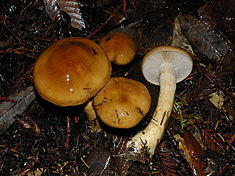- Cortinarius mucosus
-
Cortinarius mucosus 
Scientific classification Kingdom: Fungi Phylum: Basidiomycota Class: Basidiomycetes Order: Agaricales Family: Cortinariaceae Genus: Cortinarius Subgenus: Myxacium Species: C. mucosus[1] Binomial name Cortinarius mucosus
(Bull.) Cooke (1867)Synonyms Agaricus collinitus ß mucosus (Bull.) Fr.
Agaricus mucosus Bull.
Cortinarius collinitus var. mucosus (Bull.) Fr.
Myxacium mucosum (Bull.) P. Kumm.Cortinarius mucosus Mycological characteristics 
gills on hymenium 
cap is conical 
hymenium is adnexed 
stipe has a cortina 
spore print is ochre 
ecology is mycorrhizal 
edibility: inedible Cortinarius mucosus, commonly known as the orange webcap[2] or the slimy cortinarius,[3] is a species of mushroom in the family Cortinariaceae. In North America, the species is more commonly associated with northern coniferous forests.[4] The specific epithet is derived from the Latin word mucosus, meaning mucus.[5]
Contents
Taxonomy
Originally described as Agaricus mucosus by French mycologist Pierre Bulliard in 1792, Cortinarius mucosus belongs to the subgenus Myxacium (characterized by the presence of a viscid to glutinous outer veil and stipe), section Myxacium (distinguished by the presence of clamp connections), according to the infrageneric classification of the Cortinarius genus proposed by Moser in Singer (1986).[6][7]
Description
The species has a sticky brown to orange cap, 4 to 10 cm (1½ to 4 in) in diameter, that is darker towards the center and with a rolled-in margin.[2] The gills are closely spaced, have an adnexed attachment to the stipe, and are pale yellowish at first, becoming rusty brown as the spores mature.[3] Like all species in the genus Cortinarius, young specimens have a cortina, a cobweb-like annulus that protects the developing gills. The slimy stipe, 5 to 15 cm (2 to 6 in) long by 1.5 to 2.5 cm (0.6 to 1.0 in) thick,[2] is whitish until the spores mature and begin falling. The spore print is rust- to ochre-colored.[2] Both the odor and the taste of this mushroom are nondescript.[8]
The spores have a rough surface, and an elliptical shape, with dimensions of 12–14 x 5.5–6.5 µm. The basidia are 4-spored, and cystidia are not present on the edge of the gills.[8]
The species is commonly found under birch and coniferous trees.[9] It prefers acidic, sandy soils.[10]
Edibility
Due to the prevalence of toxins in the Cortinarius genus, and the difficulty of positively identifying specimens to species level, consumption of any Cortinarius species is not generally recommended.[2][3][8] Also, specimens of C. mucosus collected from northern Poland were found to bioaccumulate high concentrations of the toxic element mercury—that is, the concentration of mercury in the mature mushroom was significantly higher than that of the soil in which it grew.[11]
See also
External links
References
- ^ "Species Fungorum – Species synonymy". http://www.indexfungorum.org/Names/SynSpecies.asp?RecordID=179061. Retrieved 2009-01-19.
- ^ a b c d e "Roger's Mushrooms – Cortinarius mucosus". http://www.rogersmushrooms.com/gallery/DisplayBlock~bid~5419~gid~~source~gallerydefault.asp. Retrieved 2009-01-19.
- ^ a b c Arora, David (1986). Mushrooms demystified: a comprehensive guide to the fleshy fungi. Berkeley, Calif: Ten Speed Press. pp. 429–430. ISBN 0-89815-169-4. Google Books
- ^ Miller, Hope Ridings; Miller, Orson K. (2006). North American mushrooms: a field guide to edible and inedible fungi. Guilford, Conn: Falcon Guide. p. 321. ISBN 0-7627-3109-5. Google Books
- ^ "Online Etymology Dictionary". http://www.etymonline.com/index.php?l=m&p=23. Retrieved 2009-01-20.
- ^ Singer, Rolf (1986). The Agaricales in modern taxonomy. Koenigstein: Koeltz Scientific Books. ISBN 3-87429-254-1.
- ^ Seidl MT. (2000). Phylogenetic relationships within Cortinarius subgenus Myxacium, sections Defibulati and Myaxcium. Mycologia 92(6): 1091–1102.
- ^ a b c Jordan, Michael (1995). The encyclopedia of fungi of Britain and Europe. Newton Abbot: David & Charles. p. 271. ISBN 0-7153-0129-2. http://books.google.com/books?id=bFMfytLn3bEC&pg=PA271&dq=Cortinarius+mucosus&lr=.
- ^ First Nature
- ^ "Cortinarius mucosus (zas³onak kleisty)". http://www.grzyby.pl/gatunki/Cortinarius_mucosus.htm. Retrieved 2009-01-20.
- ^ Falandysz J, Kawano M, Swieczkowski A, Brzostowski A, Dadej M. (2003). Total mercury in wild-grown higher mushrooms and underlying soil from Wdzydze Landscape Park, Northern Poland. Food Chemistry 81(1): 21–26.
[[Category:CortinarCategories:- Cortinariaceae
- Fungi of Europe
- Fungi of North America
- Inedible fungi
Wikimedia Foundation. 2010.

